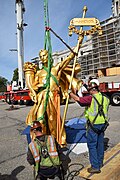
Progress of the State is the title of a group of sculptural figures that sits above the south portico, at the main entrance to the Minnesota State Capitol in Saint Paul, the state capital of the U.S. state of Minnesota.
Contents
The allegorical statuary group representing civilization is in an arrangement known as a quadriga , consisting of a chariot pulled by four horses. Three human figures, two women and a man, are included. The sculpture, made by Daniel Chester French and Edward Clark Potter, was based on their earlier Columbus Quadriga statuary, at the World's Columbian Exposition of 1893 in Chicago. It was completed and raised to the roof of the capitol in 1906. The underlying armature is steel covered in copper. The exterior copper surface is gilded in 23 karat gold leaf and requires re-gilding approximately every 20 years.










